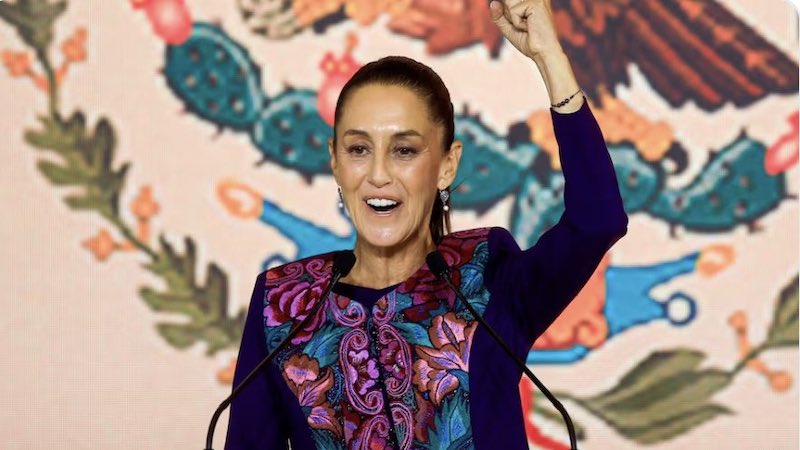
On Sunday, June 2, in the Mexican presidential elections, the victory was decisively won by the left-wing Morena (National Regeneration Movement) candidate, Claudia Sheinbaum Pardo, who was also chosen as the successor to the current colorful president, Andrés Manuel López Obrador (AMLO). Sheinbaum garnered 59.7% of the votes, the runner-up candidate of the right-wing National Action Party, Xóchitl Gálvez, received 27.4% of the votes, while the third place was taken by the Citizen Movement candidate, Jorge Máynez.
Sheinbaum will be the first woman to hold the position of President of Mexico (also the first in North America) and the candidate who has received the most votes in Mexican electoral history. She received a staggering 35.9 million votes, whereas for comparison, in 2018, her political mentor, the mega-popular López Obrador, won 30.1 million votes. This is not surprising given that the Mexican population is constantly growing (129 million), and so is the number of eligible voters (98 million). Sheinbaum is elected for a six-year term (sexenio) with no right to re-election. This is a constitutional legacy of the Mexican Revolution, according to which even temporary presidents do not have the right to re-election. She will live in the National Palace, just as AMLO did when he moved the president’s residence from Los Pinos Palace. Sheinbaum will be the first person of Jewish descent to lead the predominantly Roman Catholic United Mexican States.
Electoral Domination of the Left
Simultaneously, on June 2, elections were held for both houses of the Mexican Congress and local elections. Morena won, securing 57 seats in the Senate (65 are needed for a majority), while in the House of Representatives, Morena won 202 seats out of the needed 251. In the local elections for state governors, Morena candidates won in six out of eight gubernatorial elections (Chiapas, Morelos, Puebla, Tabasco, Veracruz, and Yucatán), and they also won the mayoralty in the capital, Mexico City/Ciudad de México, which will be held by Clara Brugada. In Guanajuato, the victory was taken by the right-wing coalition candidate, Libia García Muñoz Ledo, and in Jalisco, the Citizen Movement candidate, Pablo Lemus Navarro, won. Morena and its allies, the Labor Party (PT) and the Ecologist Green Party of Mexico (PVEM), will govern in 24 out of 32 Mexican states.
It is evident that Mexico will be under leftist rule for the next six years unless there is a conflict within their ranks, which is not impossible given the unpredictability of Latin America. This is a great success for López Obrador, as he founded Morena only about a decade ago. Morena’s victory in the elections is the result of successful policies by AMLO, such as reducing poverty and social inequality, increasing social benefits, creating new jobs, and real wage growth. The unique charismatic public appearances of the unconventional president also contributed. The new Congress will be convened on September 1, and the new president will take office on October 1.
Sheinbaum’s Political Rise
Before being elected president, Claudia Sheinbaum was recognized as the first woman to serve as mayor of Mexico City. She was born on June 24, 1962, in the same city. She grew up in a family of academics and scientists, which shaped her approach to politics and public service. She graduated in physics from the National Autonomous University of Mexico (UNAM) and later earned a PhD in energy engineering from the same university. Her academic career included research and teaching, with a particular focus on environmental and sustainable development issues. She also worked as a researcher for the Intergovernmental Panel on Climate Change (IPCC), which won the Nobel Peace Prize in 2007. She has written over 100 articles and two books on energy, the environment, and sustainable development.
Sheinbaum began her political career as a member of the Party of the Democratic Revolution (PRD) but later switched to Morena, the party founded by AMLO in 2011. Her political career started in the local government of Mexico City, where she served as the environment secretary when López Obrador was mayor. She was the mayor of the largest district in Mexico City, Tlalpan, from 2015 to 2017. In 2018, she was elected mayor of Mexico City, becoming the first woman in that position in the city’s history. Her term (December 2018 – June 2023) was marked by a series of reforms aimed at improving public transportation, reducing pollution, and enhancing security. She was proactive in combating gender violence and advocating for women’s rights.
Sheinbaum introduced numerous changes and innovations, including projects to improve energy efficiency and the use of renewable energy sources. Under her leadership, Mexico City became one of the leading cities in Latin America in implementing sustainable urban solutions. Cash distribution programs in Mexico City were better allocated to the poorest compared to the rest of the country. Scholarships were awarded to children and students. However, her term was not without challenges. She faced criticism for the rise in violence and insecurity in the city, as well as for managing the coronavirus pandemic.
Despite these challenges, Sheinbaum managed to maintain a high level of support among citizens, thanks to her determined leadership and transparent approach to city management. During the pandemic, while the federal government downplayed the importance of coronavirus testing, Mexico City expanded its testing regime and implemented stricter quarantine measures, even though the president did not prefer stricter measures to avoid harming the economy. She publicly wore a mask while the president did not. This illustrates the vivid difference between the two politicians. Sheinbaum leans more towards science, while López Obrador leans towards populism.
Election Campaign
During the campaign, Sheinbaum used the slogan “continuity with change” to emphasize her commitment to AMLO’s policies with certain changes. She promised to promote renewable energy sources while maintaining the primacy of state energy companies in the economy. She also emphasized that there would be no new permits for oil exploration after the López Obrador government halted them. Five main areas of her security strategy were: addressing the social causes of insecurity, strengthening the National Guard, enhancing the state’s capacity for investigation and intelligence gathering, improving coordination between state police and the prosecutor’s office, and reforming the judicial system. In other words, while Sheinbaum pledged to address the structural causes of crime.
Sheinbaum will not have an easy task as Mexico is ravaged by widespread crime by drug cartels, a migrant crisis, and the challenges of climate change. She will take office during one of the most violent periods Mexico has ever experienced. Under López Obrador, the military has been deployed across the country to combat cartels and enforce law and order. Despite the militarization, many parts of the country still experience violence from criminal groups. To strengthen national security and prevent murders, femicides, kidnappings, extortion, the government will need to bolster the police and judicial system.
Potential Domestic Policy
Regarding domestic policy, Sheinbaum will continue AMLO’s sovereignty policies with an emphasis on environmental protection and renewable energy sources, insisting on the rule of law. She could push for green policies in Mexico and attract foreign investors who invest in sustainable development projects. This is logical to assume given her scientific renown. As a critic of economic neoliberalism, Sheinbaum will likely continue to pursue fiscally responsible policies, reduce the state budget deficit, respect the autonomy of Mexico’s central bank, the Bank of Mexico, and maintain a stable exchange rate of the Mexican peso against the US dollar. Maintaining a stable exchange rate will be a challenge given the expected constitutional reforms of the electoral and judicial systems.
She is expected to continue López Obrador’s energy sovereignty policy. She will continue to strengthen the state oil company Pemex and the state electricity company CFE to make Mexico energy independent. Sheinbaum has supported major Pemex refinery projects – two cokers under construction and the launch of the long-delayed Olmeca refinery, which would process 340,000 barrels of oil per day, in line with López Obrador’s goal to reduce fuel imports. Overall, she supports a welfare economy that includes universal pensions and higher wages. As a feminist, she supports progressive policies such as the right to abortion, gender equality, and the LGBT agenda.
Potential Foreign Policy
Regarding foreign policy, there will be no significant changes, and the new president will continue the existing policy. This means maintaining good relations with leftist governments in Latin America, such as those in Cuba, Venezuela, and Nicaragua, as well as partnerships with the Global South (of which Mexico is a key member) and BRICS countries, emphasizing Russia, China, and Brazil. She will strive to maintain good trade relations with the US and Canada according to the free trade agreement between the three countries (USMCA), which was established in 2018 and came into force in 2020, as a kind of NAFTA 2.0. A review of the agreement is expected in 2026. The relationship with the US will be interesting if Donald Trump comes to power, given his opposition to the green agenda.
Regardless of who will be the US president in 2025, Mexico will have to deal with the American protectionist policies introduced by Trump and continued by the Biden administration. In this regard, the relationship between Mexico and the US and Mexico and China, and Mexico’s position in the US-China trade war will be interesting to observe. Sheinbaum will have a lot of maneuvering space here. Due to its geographical location, Mexico will continue to be a key country in illegal immigration from Latin America to the US. It will have a role similar to that of Turkey between the Middle East and the European Union. Mexican authorities will be able to curb or allow waves of illegal migration to the US. Sheinbaum will need to find solutions to further improve the standard of living so that fewer Mexicans want to emigrate to the US, in order to retain domestic skilled workers.
Sheinbaum Cannot Be a Puppet of AMLO
Mexico is a country that leads the Americas in gender equality. Women have been more than well-represented in politics so far, and now a woman will finally hold the most powerful political position. Claudia Sheinbaum is an extremely successful Mexican politician whose career combines scientific expertise and political skill. Her leadership in Mexico City has shown that it is possible to combine technical knowledge with social sensitivity to address complex urban challenges. As the first woman at the helm of both Mexico City and the Mexican state, Sheinbaum has laid the foundation for future generations of women in politics. As president, she will have the opportunity to demonstrate her strengths and weaknesses. Although many see her as a shadow or a remote-controlled politician of López Obrador, there is no doubt that she will profile herself and assert her leadership over time. After all, only one person can hold the position of president. This has been demonstrated by numerous cases in Latin America where so-called faceless politicians or “puppets” like Nicolás Maduro and Lenín Moreno have established themselves as undisputed leaders.
A Seemingly Comfortable Position Does Not Allow for Relaxation
The electoral success of Morena and its partners in the parliamentary elections for Congress provides an opportunity for the left to gather a two-thirds majority needed to pass changes that would reform the Mexican political system and enable easier governance. This primarily refers to the reduced funding of the National Electoral Institute (Instituto Nacional Electoral – INE) and the structural reform of the Supreme Court (judges would be elected instead of appointed, with rigorous Senate verification). This could happen even before Sheinbaum takes office on October 1, since the new Congress will be established on September 1. It is certain that the new president will not have much time to adapt to the presidential function.
Before the elections, polls showed Sheinbaum’s rating at 67%, which is less than López Obrador’s 76% approval rate at the beginning of his term. This means that Mexicans will have less patience in waiting for results from the new president. After three years in office, anyone who collects around 3 million signatures can demand a recall referendum for Sheinbaum, a change introduced by AMLO to appease critics. In such a referendum in 2022, AMLO won with 93.4% of the vote. Given her experience and expertise, Sheinbaum should continue to successfully lead Mexico as her predecessor did. However, time will provide all the answers.



